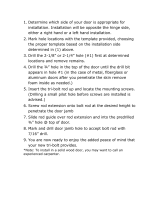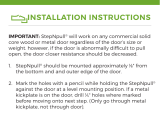Page is loading ...

4200 SVR Exit Device
Installation Instructions
I-ED01626
Rev 1, Rev Date: 07/29/14 Page 1 of 6
Vertical Centerline
Single Device
Two Vertical Rod Devices
Vertical Rod and Rim Device
Tools and Hardware Required
Door Handing
Horizontal Centerline
=>40mm
=>40mm
=>40mm
~5mm
4.5~7mm
56mm
18mm
1000mm
from finished
floor
3.5mm &
4mm
4.2mm
M5-0.8
For wood doors, drill
3.5mm hole
4.2mm drill, M5-0.8 tap
Drill 5mm thru from device
side. Drill 7mm from other
side (pull side).
Check building and fire codes
to see if your application
requires the use of sleeve
nuts and bolts.
50mm

4200 SVR Exit Device
Installation Instructions
I-ED01626
Rev 1, Rev Date: 07/29/14 Page 2 of 6
Box Contents
Fasteners and Other Parts Included
Qty.
Purpose
M5 - 0.8 x 25mm Round Head Machine Screws
6
Mount the Device Head and End Cap to a wood or metal frame.
M5 - 0.8 x 35mm Sex Nut (7.5mm Sleeve Dia)
6
Mount the Device Head and End Cap to a wood or metal frame.
M5x25mm Round Head Wood Screw
6
Mount the Device Head and End Cap to a wood frame.
M5 - 0.8 x 12mm Flat Head Machine Screws
3
Mount Strike for Double Door With Rim and SVR Exit Devices on Metal Door
M5x25mm Flat Head Wood Screw
3
Mount Strike for Double Door With Rim and SVR Exit Devices on Wood Door
M5 - 0.8 x 10mm Round Head Machine Screws
9
Mounting Both Latches and Top Strike on Metal Door and Frame
M5x25mm Round Head Wood Screw
9
Mounting Both Latches and Top Strike on Wood Door and Frame
M4x21mm Flat Head Wood Screw
3
Mounting Bottom Strike
M3.5 x 10mm Round Head Wood Screw
4
Used to Mount Vertical Rod Mounts to Wood or Metal Door.
Vertical Rod Mounts
2
Used to Hold Vertical Rods Vertically
M3.2 x 20mm Cotter Pins
2
For Fastening Vertical Rods to Head Unit Slide Bar

4200 SVR Exit Device
Installation Instructions
I-ED01626
Rev 1, Rev Date: 07/29/14 Page 3 of 6
1. Prep Exit Device For Door Size
1) Prep for door width.
a. The 4’ exit device will work for openings from widths of 650mm to 1828mm. However, for openings narrower than
1100mm, the device must be cut.
b. The 3’ exit device will work for openings from widths of 650mm to 1524mm. However, for openings narrower than
890mm, the device must be cut.
c. The recommended overall length of the exit device, for a standard single door, is equal to the opening width minus
80mm. Cut with a hack saw or metal cutting saw blade and deburr edges (do not grind cut as this may damage the
finish).
2) Prep for door height.
a. The 4’x8’ exit device comes out of the box prepped for a door height of 2439mm. For doors shorter than 2439mm in
height, the top rod must be cut down.
i. To determine the top rod length for a 4’x8’ exit device, first measure the door height and subtract it from
2439mm. Then subtract the answer from 1245mm, this answer is the desired top rod length. Example for
2000mm tall door; 2439-2000=439, 1245-439=806, desired top rod length would be 806mm.
b. The 3’x7’ exit device comes out of the box prepped for a door height of 2134mm. For doors shorter than 2134mm in
height, the top rod must be cut down.
i. To determine the top rod length for a 3’x7’ exit device, first measure the door height and subtract it from
2134mm. Then subtract the answer from 940mm, this answer is the desired top rod length. Example for
2000mm tall door; 2134-2000=134, 940-134=806, desired top rod length would be 806mm.
c. Mark the rod to required length and cut at marked spot. Keep in mind that the rod must be measured from the
threaded portions (DO NOT CUT THE ROD AT THE END WITH INTERNAL THREADS).
d. Drill cotter key connection hole with a 4.0mm Dia. Drill bit 4.5mm from the end of the rod that was just cut.
Opening Width
~40mm - from edge of frame
to end of cut
device, not end cap.
4.5mm
Desired Top
Rod Length

4200 SVR Exit Device
Installation Instructions
I-ED01626
Rev 1, Rev Date: 07/29/14 Page 4 of 6
2. PREPARE DOOR
1) Mark vertical and horizontal centerline (℄) for desired setup using the dimensions on page 1 of this instruction set.
2) Tape drilling templates #T-ED01672 on the door, using the vertical and horizontal centerlines.
3) Drill holes to sizes required for desired mount hardware for device, strikes, and latches.
4) If using outside trim, prepare door using separate trim direction sheet provided with trim.
3. Hardware Installation
1) If using outside trim, mount trim per directions in trim box.
2) Fix device with provided Sex Bolts and Through Bolts or Mounting Screws.
3) Install end cap mounting bracket with provided Sex Bolts and Through Bolts or Mounting Screws.
- Slide mounting bracket into push bar channel.
- Level the device.
- Mark mounting holes, and prepare the holes by drilling the appropriate sized holes based on mounting hardware
used.
- Install mounting bracket with hardware that was prepped for.
Channel
Mark the two holes

4200 SVR Exit Device
Installation Instructions
I-ED01626
Rev 1, Rev Date: 07/29/14 Page 5 of 6
4) Install the top and bottom strike in the locations previously prepared with mounting screws.
- Install the top strike with just the outer screws at first.
Top Strike Bottom Strike
5) Install top and bottom latches in the locations previously prepared with mounting screws.
Top Latch Bottom Latch
6) Install Bottom Rod
- Screw the bottom latch bolt fully into the bottom rod with a jamb nut and lock washer on the strike.
- Insert the bottom latch bolt into the bottom latch housing.
- Press in the push bar to raise the slide bar in the housing and slide the rod over the slide bar.
- Align the hole in the bottom rod with the hole in the slide bar and insert and tighten the cotter key.
- Adjust the latch bolt so that when the push bar is pressed that there is a gap of 2mm between the bottom of the
latch bolt and the top of the strike as shown in template T-ED01672.
Bottom Rod
Lock Washer
Jamb Nut
Latch Housing
Latch Bolt
2~5mm

4200 SVR Exit Device
Installation Instructions
I-ED01626
Rev 1, Rev Date: 07/29/14 Page 6 of 6
7) Install Top Rod
- Screw the top rod onto the top latch bolt until the lower part of the rod
can clear the housing slide bar.
- Unscrew the top rod from the top latch bolt while guiding the lower part
of the rod over the housing slide bar until the hole in the rod lines up
with the hole in the slide bar.
- Insert the cotter key, but do NOT tighten the cotter key.
- Test device to make sure the top rod locks and unlocks smoothly. Also
test the device to make sure the door opens and closes smoothly with
the top latch fully engaging.
- If the device operates as desired, tighten the cotter key and drill and
install the top strike middle screw.
- If the devise does NOT operate as desired, remove the cotter key and
adjust the rod by screwing it to raise or lower it as needed or adjust the
top strike depending on what is causing the improper operation. Repeat
steps C&D until it operates as desired.
8) Install Rod Guides
- Attached the rod guides to the rod, equidistant between the latches and device head. Drill the holes with __mm bit,
and mount with provided screws. The rod guide should not block movement of the rod.
9) Apply Covers
- Attach Head Assembly, End Cap, and Latch Covers with provided M4x8 screws.
2~5mm
/



